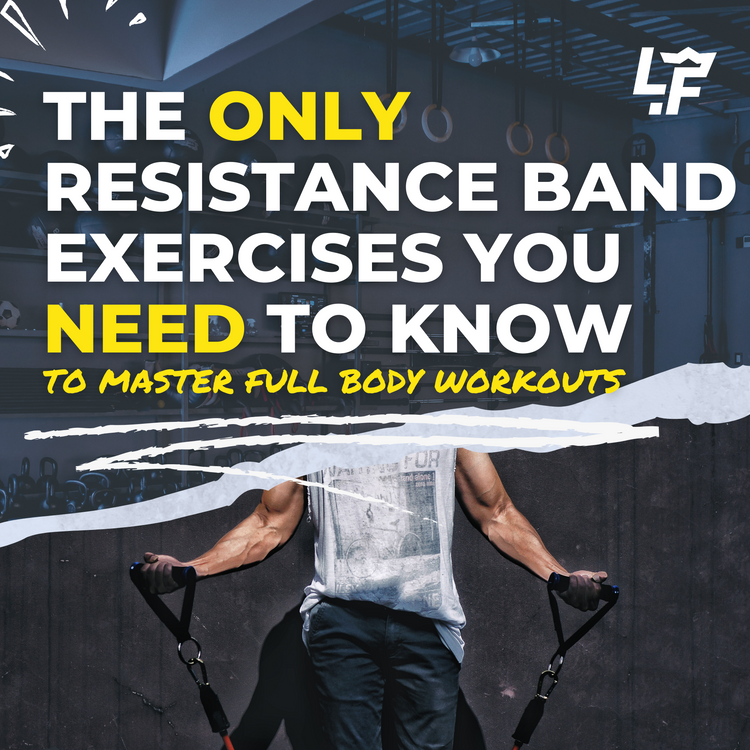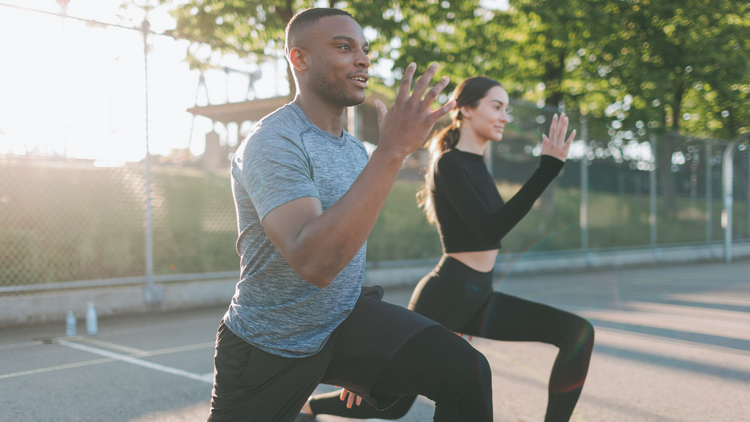Master Full Body Fitness with These 8 Resistance Band Exercises

Imagine a workout routine that challenges every inch of your body and fits conveniently into your busy schedule. Enter the world of total body pull-up band exercises – a game-changer in fitness. This article will delve into the intricacies of resistance band workouts, focusing on eight dynamic exercises that promise to transform your fitness journey. Whether you're a seasoned gym-goer or a beginner looking for an effective and versatile workout, this guide is tailored for you.
What Are Pull-Up Bands?
Pull-up bands, also known as resistance bands or exercise bands, are versatile fitness tools designed to add resistance to various exercises. They are elastic bands made from rubber or latex and come in multiple shapes, sizes, and resistance levels. Pull-up bands are widely used in strength training, rehabilitation, and general fitness routines due to their flexibility and effectiveness.
These bands are called "pull-up bands'' because one of their common uses is to assist individuals in performing pull-ups or chin-ups. When looped around a pull-up bar and placed under the foot or around the knee, they provide support by offsetting a portion of the user's body weight. This assistance is beneficial for beginners or those working towards achieving unassisted pull-ups.
Critical Characteristics of Pull-Up Bands
- Resistance Levels
- Pull-up bands come in different resistance levels, typically categorized by color or tension strength. From light to heavy resistance, users can choose bands that suit their fitness level and their specific exercise.
- Versatility
- Pull-up bands can be used for a wide variety of exercises, including but not limited to pull-ups, rows, squats, bicep curls, and shoulder exercises. Their versatility makes them suitable for both upper and lower-body workouts.
- Portable and Space-Efficient
- Unlike traditional gym equipment, pull-up bands are compact, lightweight, and easy to carry, making them ideal for home workouts, travel, or for individuals with limited space.
- Scalability
- Pull-up bands provide a scalable form of resistance. As users become stronger, they can progress to bands with higher resistance levels, ensuring a continuous challenge for muscle development.
- Inexpensive
- Compared to other gym equipment, pull-up bands are relatively inexpensive. This affordability makes them accessible to many individuals looking to enhance their fitness routine without a significant financial investment.
How Pull-Up Bands Work
Assistance in Pull-Ups
- As mentioned earlier, one of the primary uses of pull-up bands is to assist individuals in performing pull-ups. By providing support, these bands allow users to build strength gradually and work towards unassisted pull-ups.
Resistance Training
- Pull-up bands can be incorporated into various strength training exercises. When used in exercises like bicep curls, squats, or rows, the bands add resistance, making the muscles work harder throughout the entire range of motion.
Rehabilitation
- Pull-up bands are often utilized in rehabilitation exercises to aid in the recovery of specific muscle groups or joints. Their adjustable resistance levels make them suitable for individuals at different stages of rehabilitation.
Types of Pull-Up Bands
When it comes to resistance training, variety is key. Pull-up bands come in different types – loop bands and tube bands, each offering a unique resistance level. Like giant rubber bands, loop bands provide continuous tension throughout the range of motion. Tube bands, equipped with handles, allow for a broader range of exercises. The resistance levels vary from light to heavy, accommodating everyone from beginners to advanced fitness enthusiasts.
Benefits of Pull-Up Bands
Why choose pull-up bands over traditional weights? The answer lies in their versatility. These bands are scalable, portable, and adaptable to any fitness level. Pull-up bands offer a solution whether you're rehabilitating an injury or aiming for a full-body workout. Plus, their affordability makes them a wise investment for your home gym.
Importance of Total Body Workouts
Total Body Training Benefits
Why should you embrace total body workouts? It's not just about saving time; it's about maximizing efficiency. Total body training engages multiple muscle groups simultaneously, leading to increased calorie burn and improved functional fitness. By incorporating total body exercises into your routine, you're not just working out but investing in holistic well-being.
Want to Try Workouts That Burn Fat and Gain Muscle? Get Access to 40+ Different Workout Programs + Create Your Own With a Workout Generator! Follow on Desktop or Mobile!
8 Total Body Pull-Up Band Exercises
Band-Assisted Pull-Ups to Elevate Your Upper Body Strength
Band-Assisted Pull-Ups to Elevate Your Upper Body Strength
Why Do Band-Assisted Pull-Ups
Band-assisted pull-ups are an excellent entry point for individuals looking to conquer the challenging pull-up. These exercises build the strength and confidence needed to eventually perform unassisted pull-ups by assisting in the upward phase.
Targeted Muscles
Primarily targets the latissimus dorsi, biceps, and forearms.
How To Do Band-Assisted Pull-Ups
- Secure the pull-up band on a horizontal bar.
- Place one foot or knee in the loop, adjusting resistance as needed.
- Hang from the bar, engage your core, and pull yourself upward.
- Lower yourself back down with control, maintaining tension in the band.
Band Rows to Sculpt Your Back with Precision
Why To Do Band Rows
Band rows isolate and target the back muscles, promoting muscle growth, improved posture, and overall upper body strength.
Targeted Muscles
Engages the latissimus dorsi, rhomboids, and traps.
How to do Band Rows
- Anchor the band at chest height.
- Hold the handles, step back to create tension, and maintain a firm stance.
- Pull the handles towards your chest, squeezing your shoulder blades together.
- Slowly return to the starting position, keeping tension in the band.
Band Pull-Aparts for Shoulders and Upper Back Harmony
Why Do Band Pull-Aparts
Band pull-aparts enhance shoulder stability, correct imbalances, and reduce the risk of injuries, making them a vital exercise for overall shoulder health.
Targeted Muscles
Targets the rear deltoids and upper back muscles.
How To Do Band Pull-Aparts
- Hold the band with both hands at shoulder width.
- Keep your arms straight and pull the band apart, focusing on the shoulder blades.
- Return to the starting position with control, maintaining tension in the band.
Band Bicep Curls for Building Sleeve-Busting Arms
Why Do Band Bicep Curls
Band bicep curls provide constant tension on the biceps, promoting muscle isolation and a deep, effective burn.
Targeted Muscle
Isolates and sculpts the biceps.
How To Do Band Bicep Curls
- Stand on the center of the band, holding the handles with arms fully extended.
- Curl the handles towards your shoulders, contracting your biceps.
- Slowly lower the handles back down, maintaining tension in the band.
Want to Try Workouts That Burn Fat and Gain Muscle? Get Access to 40+ Different Workout Programs + Create Your Own With a Workout Generator! Follow on Desktop or Mobile!
Band Squats to Redefine Legs
Why Do Band Squats
Band squats intensify the classic squat, engaging the quadriceps, hamstrings, and glutes while promoting stability.
Targeted Muscles
Activates the quadriceps, hamstrings, and glutes.
How To Do Band Squats
- Step on the band with feet shoulder-width apart.
- Hold the handles at shoulder height.
- Perform a squat, keeping your back straight and knees aligned with your toes.
- Return to the starting position, maintaining tension in the band.
Band Lunges for the Stability and Strength
Why To Do Band Lunges
Band lunges enhance stability and strengthen the lower body, targeting the quadriceps, hamstrings, and glutes.
Targeted Muscles
Targets the quadriceps, hamstrings, and glutes.
How To Do Band Lunges
- Step one foot backward, placing the band under the front foot.
- Hold the handles at your sides.
- Lower your body into a lunge position, ensuring the back knee hovers above the ground.
- Return to the starting position, keeping tension in the band.
Band Woodchoppers for Dynamic Core Activation
Why Do Band Woodchoppers
Band woodchoppers dynamically engage the core, working the obliques, rectus abdominis, and transverse abdominis for a well-defined midsection.
Targeted Muscles
Targets the obliques, rectus abdominis, and transverse abdominis.
How To Do Band Woodchoppers
- Attach the band high on a stationary point.
- Hold the band with both hands and rotate your torso as you pull the band diagonally across your body.
- Return to the starting position, maintaining control and tension in the band.
Band Plank Rows for Core and Upper Body Integration
Why Do Band Plank Rows
Band plank rows combine core stabilization with upper body strength, offering a two-in-one exercise for a comprehensive workout.
Targeted Muscles
Engages the core, back muscles, and shoulders.
How To Do Band Plank Rows
- Begin in a plank position with the band secured under your hands.
- Row one handle towards your hip, engaging your back muscles.
- Return the handle to the ground, maintaining a stable plank position.
- Repeat on the other side, alternating rows while keeping the core tight.
Conclusion
Mastering fitness with total body pull-up band exercises is more than a trend; it's a transformative approach to holistic well-being. The versatility and efficiency of pull-up bands make them an invaluable addition to any fitness routine. By understanding the types of bands, embracing total body workouts, and incorporating the eight exercises outlined in this guide, you're on the path to a more robust, fitter, and healthier you.
Want to Try Workouts That Burn Fat and Gain Muscle? Get Access to 40+ Different Workout Programs + Create Your Own With a Workout Generator! Follow on Desktop or Mobile!
Additional Tips
- Ensure proper form in each exercise to maximize effectiveness and prevent injuries.
- Gradually increase resistance as your strength improves.
- Consult with a fitness professional or healthcare provider if you have any pre-existing conditions or concerns.
- Refer to reputable fitness websites, books, and scientific studies for additional resources and in-depth information. Some references include,
- American Council on Exercise (ACE)
- National Academy of Sports Medicine (NASM)
- PubMed Central for scientific studies and research articles.
By incorporating these practices, you'll not only master fitness with pull-up bands but also cultivate a sustainable and enjoyable workout routine.
Helpful Resources:
- Be alerted when we publish more like this to our blog here
- Daily workout plans here
- Fitness Equipment like resistance bands here
- Free weekly resistance bands written workouts here
- Follow along with $1 video workouts here











Choosing the proper resistance and size (length) seems complicated. Any suggestions?
Truly enjoyed your videos.